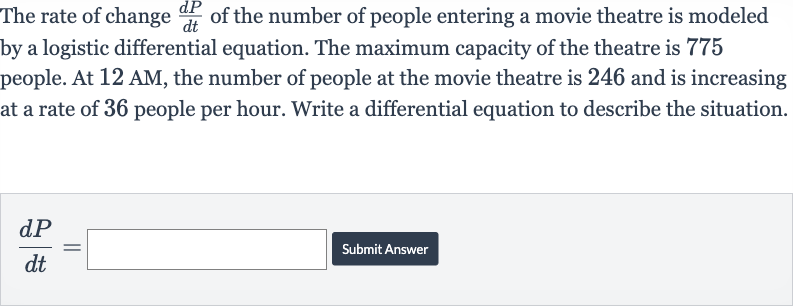AI tutor
Welcome to Bytelearn!
Let’s check out your problem:

The rate of change of the number of people entering a movie theatre is modeled by a logistic differential equation. The maximum capacity of the theatre is people. At , the number of people at the movie theatre is and is increasing at a rate of people per hour. Write a differential equation to describe the situation.
Full solution
Q. The rate of change of the number of people entering a movie theatre is modeled by a logistic differential equation. The maximum capacity of the theatre is people. At , the number of people at the movie theatre is and is increasing at a rate of people per hour. Write a differential equation to describe the situation.
- Logistic Differential Equation: The logistic differential equation is generally given by the formula:where is the population at time , is the intrinsic growth rate, and is the carrying capacity, which in this case is the maximum capacity of the theatre.
- Maximum Capacity of Theatre: We are given that the maximum capacity of the theatre is people. This is the carrying capacity in our logistic model.
- Initial Condition: We are also given that at AM, the number of people is and is increasing at a rate of people per hour. This gives us the initial condition for and the rate of change at that specific time.
- Finding Intrinsic Growth Rate: To find the intrinsic growth rate , we use the given rate of change when . Plugging these values into the logistic equation, we get:Now we solve for .
- Calculating Fraction: First, calculate the fraction of the carrying capacity:
- Solving for r: Now, solve for :
- Complete Logistic Differential Equation: Now that we have the value for , we can write the complete logistic differential equation:This is the differential equation that describes the situation.
More problems from Interpreting Linear Expressions
QuestionGet tutor help
